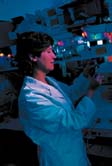
From
big lizards to astrocytomas The defining aspect of this mechanism, says Cala, is that as sodium and hydrogen - both charged ions - move through cell membranes in this one-for-one ratio, "they do not generate electricity." The study, published in the Journal of General Physiology, "became a citation classic," says Cala. The so-what? for human beings is that many diseases are associated with abnormal cellular pH and disrupted cell volume. Cala and co-worker Steven Anderson, an associate researcher in physiology at UC Davis, have proven that during hypoxia and ischemia, the sodium-proton exchanger functions as a pH regulator. As such it contributes to the damage that occurs during heart attacks and strokes because it overloads the cell with sodium and calcium ions. "Living cells control their intracellular acidity very carefully," says Cala. "A whole class of path- ologies, from heart attacks to cancer, are associated with abnormalities in cell volume and pH and they seem to be characterized by increases in this enzyme." New drugs that inhibit the sodium-proton exchange in an effort to limit damage to oxygen-starved heart muscle cells are already in development.
Home |
Table of Contents |
To our Readers |
Building on Basics UC Davis Health System | © 2000, 2001, 2002 UC Regents. All rights reserved. |
Graduate student Lee Anne McLean watches changes in fluorescent dye in glial cells. |

